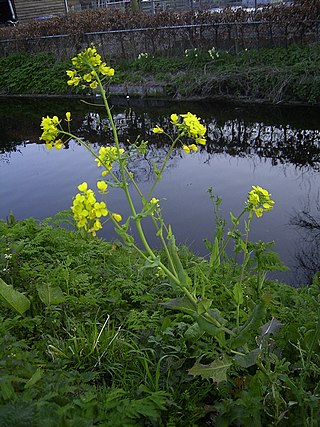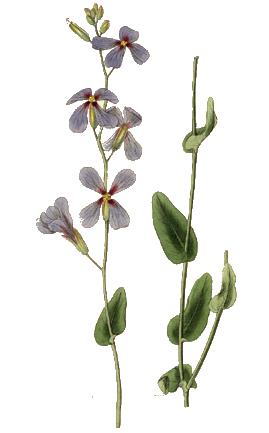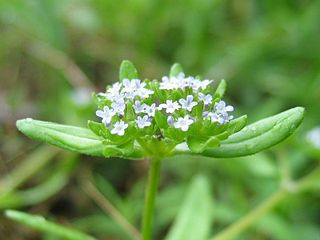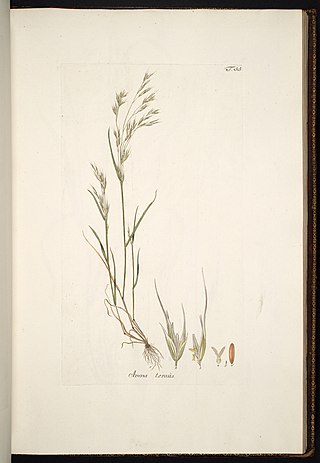
Brassica is a genus of plants in the cabbage and mustard family (Brassicaceae). The members of the genus are informally known as cruciferous vegetables, cabbages, or mustard plants. Crops from this genus are sometimes called cole crops—derived from the Latin caulis, denoting the stem or stalk of a plant.

Genista is a genus of flowering plants in the legume family Fabaceae, native to open habitats such as moorland and pasture in Europe and western Asia. They include species commonly called broom, though the term may also refer to other genera, including Cytisus and Chamaecytisus. Brooms in other genera are sometimes considered synonymous with Genista: Echinospartum, Retama, Spartium, Stauracanthus, and Ulex.

Fumaria is a genus of about 60 species of annual flowering plants in the family Papaveraceae. The genus is native to Europe, Africa and Asia, most diverse in the Mediterranean region, and introduced to North, South America and Australia. Fumaria species are sometimes used in herbal medicine. Fumaria indica contains the alkaloids fuyuziphine and alpha-hydrastine. Fumaria indica may have anti-inflammatory and analgesic potential.

Melilotus, known as melilot, sweet clover, and kumoniga, is a genus in the family Fabaceae. Members are known as common grassland plants and as weeds of cultivated ground. Originally from Europe and Asia, it is now found worldwide.

Moricandia is a genus of plants of the family Brassicaceae. This genus is mainly distributed in North Africa, the Middle East, and Southern Europe. It is associated with arid and semi-arid environments. Flowers of this genus are actinomorphic-dissymmetrical and mostly lilac in color, although they vary from white to purple depending on the species and climatic conditions. Some species show extreme phenotypic plasticity for flower size, shape, and color. The fruits are two-valved dehiscent siliques with one or two sets of seeds per valve.

Catananche is a genus of flowering plants in the family Asteraceae. It is native to dry meadows in the Mediterranean region.

Erodium is a genus of flowering plants in the botanical family Geraniaceae. The genus includes about 60 species, native to North Africa, Indomalaya, the Middle East, and Australia. They are perennials, annuals, or subshrubs, with five-petalled flowers in shades of white, pink, and purple, that strongly resemble the better-known Geranium (cranesbill). Cultivated plants are known as filarees or heron's bill in North America, whereas in the British Isles they are usually called storksbills.

Valerianella is a genus of plant in family Caprifoliaceae. Many plants of this genus are known by the common name corn salad or cornsalad, although that name most often refers to Valerianella locusta.

Filago is a genus of plants in the sunflower family, native from Europe and northern Africa to Mongolia, Nepal, and Macaronesia. They are sometimes called cottonroses or cudweeds.

Anthemideae is a tribe of flowering plants in the family, Asteraceae, and the subfamily Asteroideae. They are distributed worldwide with concentrations in central Asia, the Mediterranean Basin, and southern Africa. Most species of plant known as chamomile belong to genera of this tribe.

Ventenata is a genus of plants in the grass family, native to Europe, North Africa, and central + southwest Asia. One species, Ventenata dubia, is considered an invasive weed in many places.

Dasypyrum is a genus of Eurasian and North African plants in the grass family, native to the basins of the Mediterranean, Black, and Caspian Seas.

Plocama is a genus of flowering plants in the family Rubiaceae. It was described by William Aiton in 1789. It is distributed from the Canary Islands to northwestern India.

Jean-Louis Kralik was a French botanist.

Ferulago is a genus of flowering plants in the family Apiaceae.
Hohenackeria is a genus of flowering plants belonging to the family Apiaceae.
Kremeriella is a monotypic genus of flowering plants belonging to the family Brassicaceae. It has one known synonym KremeriaCoss. & Durieu. It only contains one species, Kremeriella cordylocarpus(Coss. & Durieu) Maire
Selinopsis is a genus of flowering plants belonging to the family Apiaceae.
Henophyton is a genus of flowering plants belonging to the family Brassicaceae.
Deverra is a genus of flowering plant in the family Apiaceae, native from northern Africa to the Arabian Peninsula and Iraq, and to south tropical and southern Africa. The genus was first described by Augustin de Candolle in 1829.















